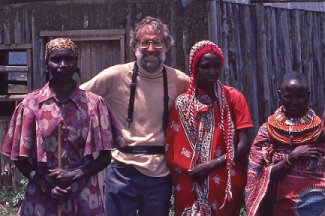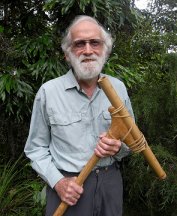
First and Only Weekly Online Fanzine Devoted to the Life and Works of Edgar Rice Burroughs Since 1996 ~ Over 15,000 Web Pages in Archive presents Volume 5499a Alternate: www.johntyman.com/africa |

First and Only Weekly Online Fanzine Devoted to the Life and Works of Edgar Rice Burroughs Since 1996 ~ Over 15,000 Web Pages in Archive presents Volume 5499a Alternate: www.johntyman.com/africa |
|
Cultures in Context Series  |
|
FOREST, GRASSLAND AND SLUM Studies of the Maasai, the Luhya, and Nairobi's Urban Fringe |
|
II. Sound Effects Library III. Kenyan Folk Tales IV. Kenyan Country Foods |
| . | . |
| . |
|
| . | This study of three different habitats in East Africa is, at one and
the same time, the most dated and the most recent of the studies of ”Cultures
in Context” posted on the World Wide Web. This is because although almost
all of the Samburu images, most photos of the Luyha, and all of the sound
recordings, were collected in 1982, their story has been updated using
photos and emailed information provided by faithful friends. My notes on
the Luhya were checked and updated by Charles Mudanyi (now living in Busia)
who has been a source of valuable information since I stayed with his family
in 1982. He has also provided photos illustrating changes that have been
made since then.
The unit detailing life on the urban fringe of Nairobi is essentially the work of Olita Ogonjo. He took all the photos and later explained them to me. All I contributed was a camera or two and a list of the images I needed. The photographs he was able to collect reflect the community’s trust in one who had long since identified himself with their just desire for improved living conditions. As a visitor from a very different world I could not have taken them myself. And Olita was also able to update my coverage of conditions in northern Kenya among the Samburu and their neighbours – and provide additional pictures. I flew to Kenya in August 1982 -- when the residences of my university in Brisbane were commandeered for athletes competing in the Commonwealth Games. I spent two months among pastoral tribes in the north, courtesy of the Rural Development Centre at Maralal, and visited a number of Samburu settlements within walking distance of the town. In the account that follows the lines between the cultures of the Samburu in the north and the Maasai in the south have been blurred because they have so much in common. I followed this up with two months in the Western District courtesy of Richard Ong’anda, principal of the school at Ingotse and a former student of mine in Canada. With his home as my base I was able to spend time with several different families, notably the Mudanyis. After that I invested several rolls of film and a great deal of energy in documenting the zonation of vegetation types on Mount Kenya (from tropical forest to snow-capped peaks) before I left Kenya for the Sahara. |
| 1. | Land and People : 001-008 |
| 2. | Environmental Considerations : 009-012 |
| 3. | Political and Economic Characteristics : 013-022 |
| . |
|
| 4. | LAND AND PEOPLE : 023-029 |
| 5. | CLOTHING : 030-035 |
| 6. | FOOD : 036-050 |
| 6a. | FOOD : 051-063 |
| . | AGRICULTURAL CASE STUDIES: |
| 7. | The Adanje Shamba : 064-071 |
| 8. | The Onyimbo Shamba : 072-079 |
| 9. | The Okala Shamba : 080-086 |
| 10. | The Mumias Sugar Company : 087-097 |
| 11. | SHELTER : 098-123 |
| 12. | FAMILY : 124-143 |
| . | FAMILY CASE STUDIES: |
| 13.
14. |
The Tsuma Family : 144-153
The Mudanyi Family : 154-176 |
| . | BUSINESS ENTERPRISES: |
| 15. | Markets : 177-198 | Pottery : 199-206 ~ 177-206 |
| 16. | Working with Fibres : 207-213 | Brewing : 214-216 ~ 207-216 |
| 17. | Trapping Quails : 217-221 | Charcoal Making : 222-227 ~ 217-227 |
| 18. | Working with Wood : 228-231 | Brick Making : 232-235 ~ 228-235 |
| 19. | TRANSPORTATION : 236-250 |
| 20. | EDUCATION : 251-275 |
| 21. | HEALTH : 276-280 | RELIGION : 281-289 |
| 22. | CHANGES UNDERWAY : 290-300 |
| . |
|
| 23. | The People : 301-304 |
| 24. | Environment : Vegetation : 305-313 |
| 25. | Environment : Wildlife : 314-332 |
| 26. | Basic Values and Beliefs : 333-334 | Economic Aspects : 335-343 |
| 27. | Maasai Villages : 344-352 |
| 28. | Maasai Houses : 353-365 |
| 29. | Clothing and Decoration : 366-382 |
| 30. | Social Organization : 383-392 |
| 31. | The Life of a Moran : 393-405 |
| 32. | Women’s Work : 406-420 |
| 32a. | Women's Work : 421-438 |
| 33. | Village Schools : 439-455 |
| 34. | Women as Agents of Change : 456-468 |
| 34a. | Women as Agents of Change : 469-482 |
| 35. | Health Issues : 483-486 | The Role of the Church : 487-492 |
| 36. | Future Prospects : 493-500 |
| . |
|
| 37. | Introduction : 501-508 | Kibera : An Overview : 509-518 |
| 38. | Housing and Basic Services : 519-528 |
| 39. | Health and Sanitation I : 529-544 |
| 39a. | Health and Sanitation II : 545-557 |
| 40. | Income and Employment I : 558-571 |
| 40a. | Income and Employment II : 572-586 |
| 41. | Educational Facilities : 587-599 |
| 41a. | Educational Facilities : 600-616 |
| . | Glimpses of Family Life: |
| 42. | Lillian and Yvonne : 617-624 | Belita Katela : 625-630 |
| 43. | Sam's Aunt Cheryl : 631-646 |
| 44. | The Australian Connection : 647-662 |
| 45. | Community Initiatives : 663-676 |
| 46. | Conflict and Resolution I : 677-687 |
| 46a. | Conflict and Resolution II : 688-700 |
![]()
II. SOUND EFFECTS LIBRARY
 |
108 Sound Bytes with Descriptive Text |
 |
III. KENYAN FOLK TALES
|
IV. KENYAN COUNTRY FOOD
|
|
Cultures in Context Series INTRO AND CONTENTS ARCTIC | NEW GUINEA | AFRICA | NEPAL | SAHARA . |

![]()
Text, photos and recordings
by John Tyman
Intended for Educational Use
Only.
Contact Dr. John Tyman at johntyman2@gmail.com
for more information regarding
licensing.
www.hillmanweb.com
Photo processing, Web page layout,
formatting and hosting by
William
Hillman ~ Brandon, Manitoba ~ Canada
![]()
![]()

![]()
![]()

![]()
BILL
HILLMAN
Visit our thousands
of other sites at:
BILL
AND SUE-ON HILLMAN ECLECTIC STUDIO
ERB Text, ERB
Images and Tarzan® are ©Edgar Rice Burroughs, Inc.-
All Rights Reserved.
ERB quotes ©ERB Inc.
All Original
Work ©1996-2017 by Bill Hillman and/or Contributing Authors/Owners
No part of this
web site may be reproduced without permission from the respective owners.